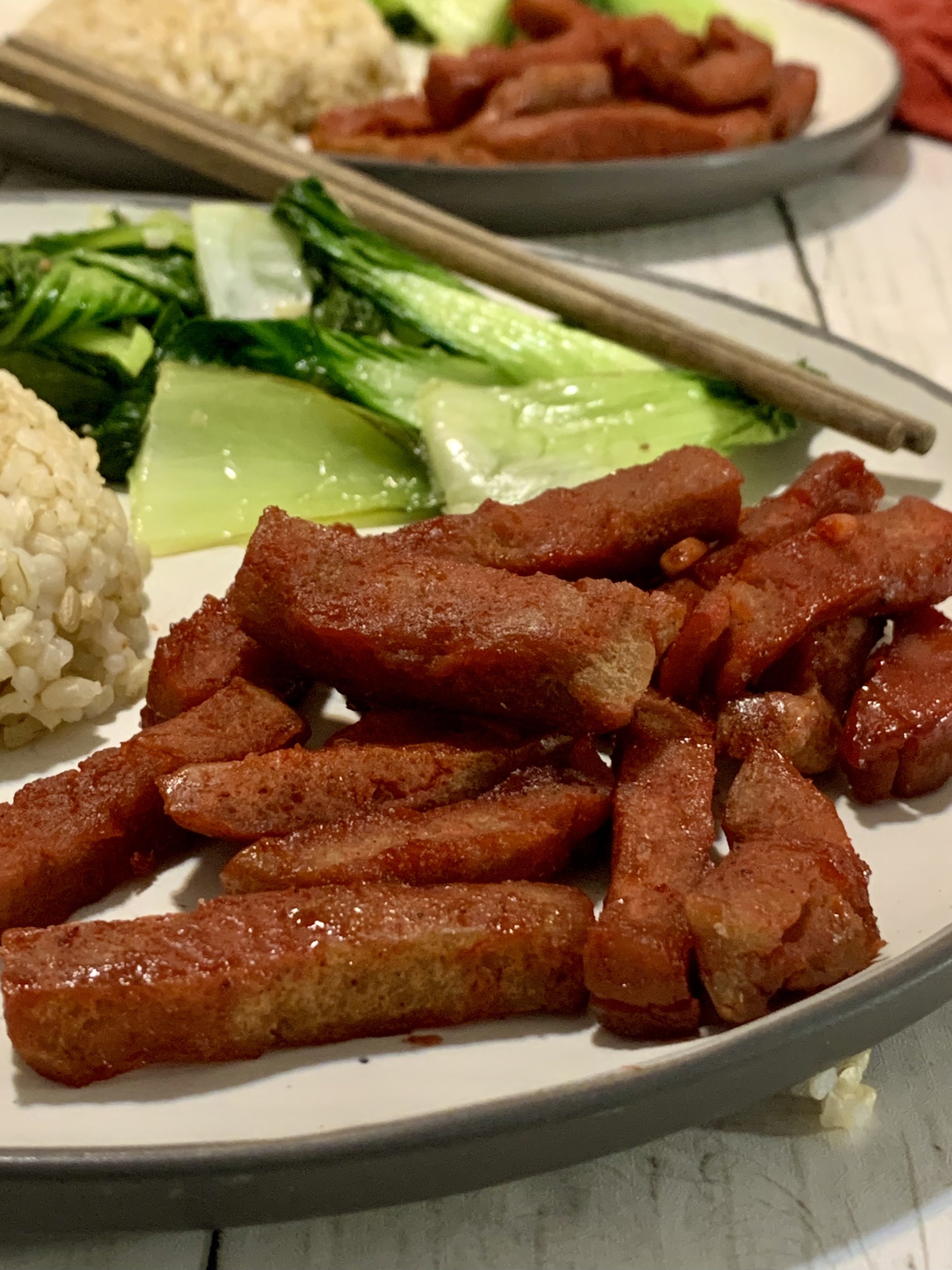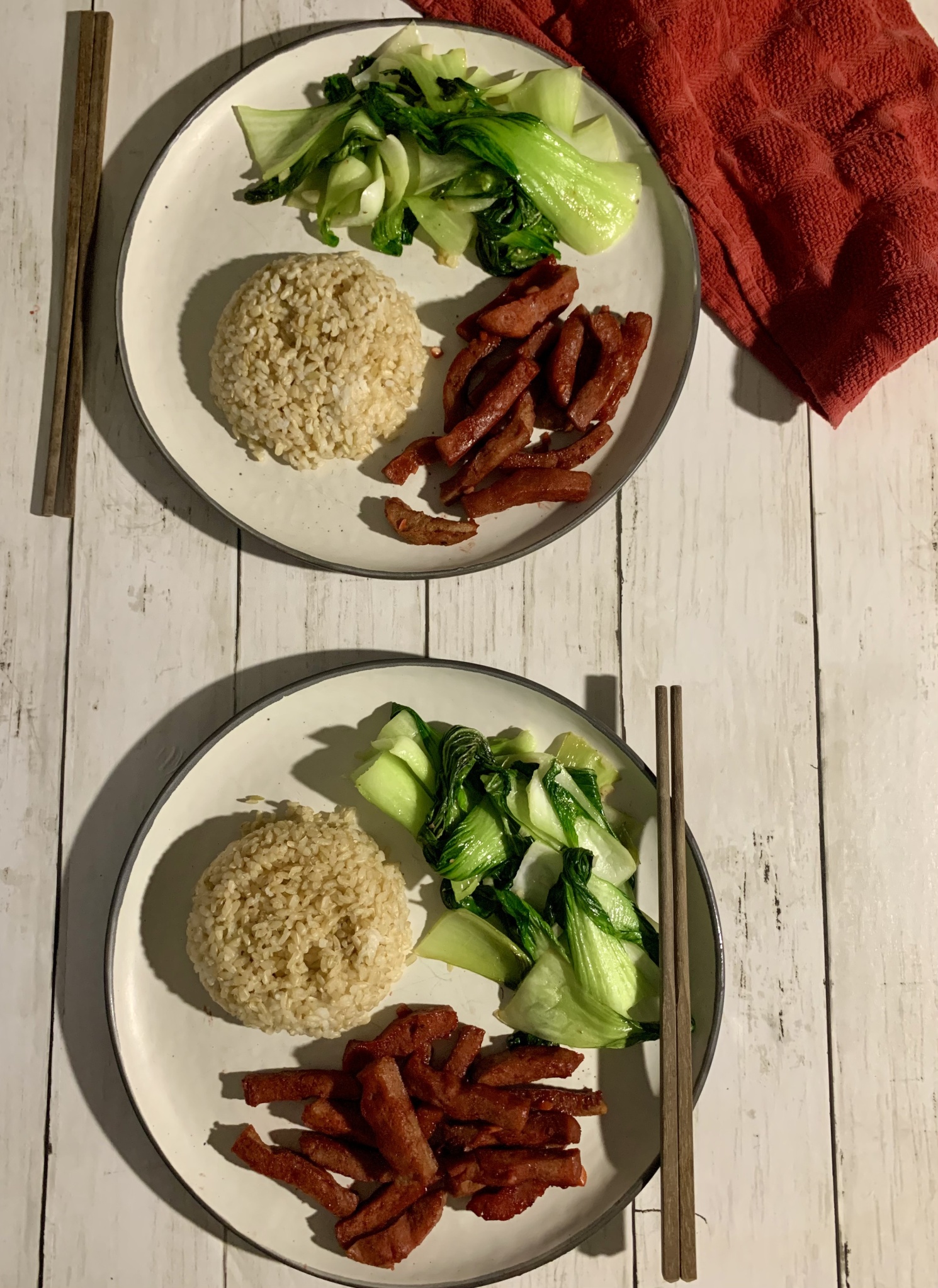
If you’ve been to a Chinese restaurant serving dim sum, then you’ve probably seen the fluffy white steamed buns filled with a sweet and flavorful red-hued pork. This was always my favorite dim sum dish – a bao bun filled with char siu, a Cantonese barbecue roasted pork. I loved the glossy meat that had a slight crunch on the outside but was tender on the inside. Lucky for me, Chinese cooking also has a history of using mock meat substitutes like seitan to create dishes like vegan char siu so I was able to continue enjoying this dish after becoming a vegetarian.
My first experience with vegetarian Chinese food was at age 20 when I went to Philadelphia with some friends and we went to Chinatown. I was a bit reluctant to try the mock meat, as I wasn’t sure exactly what I was eating, but I was glad that I did because I found it delicious and similar to actual pork. Today I am lucky enough to live in a city that has not one, but two Chinatowns, which include vegetarian dim sum restaurants. My favorite is The Original Buddha Bodai Kosher Vegetarian Restaurant which serves incredible vegetarian char siu buns as well as sliced mock meat alongside greens and rice. But not everyone lives near a dim sum restaurant that has vegetarian options, or perhaps you want to try your hand at cooking Chinese food at home. Although I’ve experimented with a number of other Asia-inspired recipes including this Sichuan Chili Oil Fried Rice, I’m relatively new to cooking Chinese cuisine. But I wanted to expand my culinary skills and learn how to make vegan char siu. Let’s see what we can learn!
Char Siu Origin Story
Char siu is a Cantonese dish, originating in Guangdong Province in South China. The literal translation of char siu means “fork roasted” in Cantonese, and it’s a reference to the original preparation technique of skewering seasoned boneless pork on long forks and slow roasting it over a fire or in an oven. Today it is typically made from pork, although some sources say its ancient preparation used wild boar. This dish is OLD…really, really old. According to one source I found, there is evidence of this dish being cooked dating back 3,000 years, making char siu recipes older than Egyptian hieroglyphics or the Bible. It’s a testament to how good it is that it has withstood the test of time.
The popularity of this dish has spread throughout the world and char siu is featured in dishes throughout South East Asia. It’s served everywhere from Michelin-starred restaurants to street food carts. It’s a common food for celebrations and Lunar New Year, due to its red color and the symbolism of having pork at the table. Mock meat versions using seitan are also common, particularly in restaurants catering to vegetarian Buddhists.

What’s in vegan char siu?
I developed this recipe by consulting several online recipes that used pork (all sources are at the end), adjusted for the seitan, and tested four main recipes side by side to see which I liked best. A char siu marinade typically contains garlic, soy sauce, hoisin, honey or maltose, five spice powder, sesame oil, Shaoxing wine, white pepper, and something to color it red. I’ve made some adjustments to veganize it below and you’ll also find some tips on where to purchase the ingredients.
Seitan: The most common substitute for pork, which also has its roots in Chinese culture. Seitan is made from high-protein wheat gluten and has been widely consumed in China as far back as the 6th century as a meat replacement for vegetarian Buddhists. Today, many of the meat substitute products you see at the grocery story or in restaurants are made with seitan! You can make your own, but my preference for this recipe was to purchase these traditional seitan strips from Sweet Earth. The seitan is already cut into strips for you, and the shape holds throughout the recipe. I did not have luck with other store-bought brands of seitan that I tried – they crumbled completely during the marinating and cooking process. You’ll want to look in the refrigerated “vegan” section of your grocery store (this is typically where you’ll find tofu, vegan cheese, or Beyond meat) and you might have better luck at a health food store or Whole Foods. Although many grocery stores in my area do stock Sweet Earth brand, I found this particular product a bit tricky to find consistently, but it’s also the only product I had success with for this recipe. My recommendation is to plan ahead and get the strips if you can.
Yellow miso paste: You won’t find miso in a pork char siu recipe, but in a vegan version it gives the seitan an umami punch. You can find miso paste at an Asian grocery store or you may find it in the refrigerated section where they sell other vegan foods. Miso paste is a good investment if you like vegetarian and vegan foods, as it can replace umami and lasts a long time.
Soy sauce: I used one with 50% less sodium, so if using a regular soy sauce I’d recommend reducing the salt in the recipe.
Hoisin: This sweet sauce is sold in most grocery stores and is typically vegan.
Five spice powder: A spice mix common in Chinese cooking that contains star anise, cloves, cinnamon, Sichuan pepper, and fennel. You’ll likely find this in the spice section of your grocery store or, if you have all the spices on hand, you can mix your own.
Maple syrup: Most char siu recipes are made with honey or, in the most traditional cases, maltose which is another sweetener. I used maple syrup because it’s easy to find in the US and vegan.
Smoked paprika: Also not a traditional ingredient if using pork, but when making the vegan version this spice adds some smokiness that would otherwise be missing. It also contributes to the red color.
Sesame oil: This is easy to find in most grocery stores and a small amount gives the dish a nutty taste.
Shaoxing wine: A type of Chinese rice wine that is from Shaoxing province. It’s used widely in Chinese cooking and should be easy to find at an Asian / Chinese grocery store. It’s not the same as rice wine, as I found it to have a deeper, more complex flavor. This was a new ingredient for me, but if you want to do more Chinese cooking, it’s a good investment to get the flavors right and it’s not terribly expensive – I picked up a bottle for $4.99. If you’re new to Chinese cooking and don’t want to make this investment (I don’t blame anyone who doesn’t want to buy a product they may never use again for a 1/2 teaspoon), it seems most people have substituted cooking sherry or rice wine. I didn’t try these adaptations.

White pepper: Did you know that white pepper and black pepper come from the same plant, and that what’s different is the ripeness of the berries? White pepper comes from pepper berries that are fully ripened. In Chinese cooking, white pepper appears to be more common than black so if you want the most authentic taste, this is what I’d recommend. I found it at my local Chinese grocery store but I expect you’d be able to find it at many stores.
Red food coloring: This is totally optional and perhaps controversial, as many people are opposed to food coloring. But if you want to make your vegan char siu pop with the expected red color, this is what I recommend. It doesn’t impact the taste, so if you don’t want to use it, that’s fine! In traditional Chinese cooking, red fermented bean curd is used to get the red color which is another option but might be harder to find. It also has more impact on the flavor than food coloring and I didn’t test the recipe with this ingredient.
How do you make vegan char siu?
One bonus of vegan char siu is that it is much quicker to prepare than pork. The marination and cooking time are both shorter so you’ll have dinner on the table much faster. All you need to do is make the sauce, let the seitan strips marinate for about an hour, and bake them for 25 minutes or until crispy. That’s it!
Many restaurants will serve char siu with rice and steamed greens, so I too served it with brown rice and baby bok choy sauteed with garlic and a few grinds of white pepper. You can also use this recipe as a starting point for other dishes like char siu bao.
Sources: Chinese BBQ Pork Cha Siu, Char Siu Chinese BBQ Pork, Why Char Siu is Old Hong Kong’s Classic Comfort Food, World Famous Char Siu, The Secret Life of Char Siu Bao, Char Siu Wikipedia page

Vegan Char Siu (Chinese BBQ Pork)
1 hour 30 minutes (includes 1 hour marination time)
Ingredients
Marinade:
- 1 cup hot water
- 1 tablespoon yellow miso
- 2 cloves garlic, minced
- 1 tablespoon soy sauce
- 1 1/2 teaspoon hoisin sauce
- 1 1/2 teaspoons maple syrup
- 1/2 teaspoon five spice powder
- 1/2 teaspoon smoked paprika
- 1/2 teaspoon salt
- 1/2 teaspoon sesame oil
- 1/2 teaspoon Shaoxing wine
- 1/8 teaspoon white pepper
- A few drops red food coloring (optional)
- 1 pound seitan strips (strongly recommend Sweet Earth Traditional Seitan Strips)
- 1 tablespoon maple syrup (for glaze)
Equipment
- Oven
- Parchment paper
- 2 medium bowls
Directions
Make the marinade. Whisk the miso in the hot water until it has fully dissolved. In a medium bowl, mix together all the marinade ingredients: garlic, soy sauce, hoisin, maple syrup, five spice, smoked paprika, salt, sesame oil, Shaoxing wine, white pepper, and food coloring. Add the miso water to the bowl and stir to combine.
Marinate the seitan. Pour the marinade over the seitan strips and let sit for one hour.

Bake the seitan. 10 minutes before you want to bake the seitan, heat the oven to 350˚F and prepare a baking sheet with parchment paper. Lay out the seitan strips on the parchment paper. Reserve 2 tablespoons of the marinade. Bake the seitan for 10 minutes. Add 1 tablespoon maple syrup to the reserved marinade and stir to make the glaze. Remove seitan from the oven and flip the strips over. Brush with the marinade and maple syrup glaze. Bake for 15 more minutes or until crispy on the outside.

Serve the vegan char siu! Best served with a side of sautéed baby bok choy and rice.

